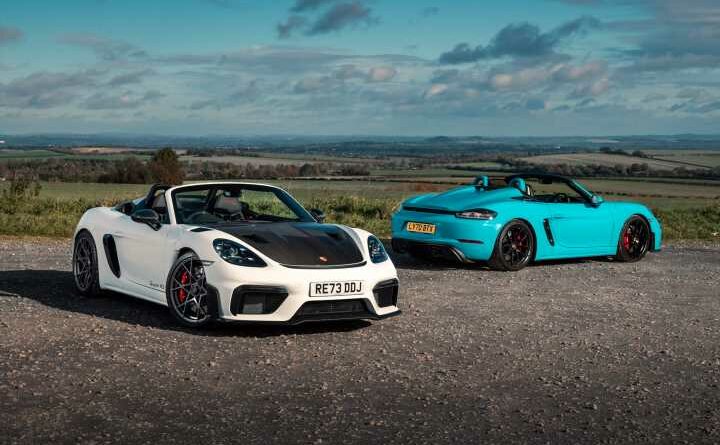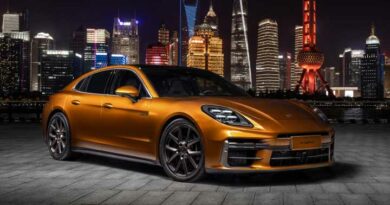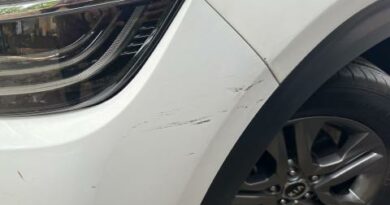2023 Porsche 718 Spyder RS vs. Porsche 718 Spyder
Is the Spyder RS really Porsche perfection, or a GT product too far? One way to find out…
By Matt Bird / Saturday, 11 November 2023 / Loading comments
Once upon a time not so very long ago, it seemed that the Porsche 718 Cayman GT4 RS was the greatest road racer to ever leave Zuffenhausen. Light, compact, fast, relatively uncomplicated and blessed with one of the world’s finest powertrains, it was mind-blowingly good at launch. Then slightly less inspirational in the UK: a bit too mad, too loud, too stiff to really get along with on tarmac that didn’t have a start-finish line on it. The 992 GT3 RS proved the point (a more usable road car, believe it or not) and then came the 718 Boxster Spyder RS, with a little caveat in its spec…
‘Compared to the 718 Cayman GT4 RS, which is designed for the best possible lap times, the damper rates in the new 718 Spyder RS have been reduced to enable the car to adapt even more effectively to different road conditions. This allows the roadster to provide the driver a confidence-inspiring level of grip on winding country roads in particular, with safe and predictable handling at all times.’ It was hardly a concession as such – not least with a whole host of track adjustability still plumbed in – though perhaps an admission that the Cayman leaned a tad too heavily on the ‘racer’ side of the road racer equation. So here’s a winding country road, a Spyder RS, and a very simple question – has it worked?
Actually, scratch that, there’s more than one question to answer here. You’ve probably noticed the Miami Blue Porsche as well, a 718 Spyder lent to PH by Maundrells for the irresistible comparison. In softening off the RS, might the 500hp Boxster be drawn a little too close for comfort to the 420hp one? Can it justify a premium that totalled £50k going on list price (and surely much more in reality)? Is an 8,000rpm, manual Porsche a more enjoyable car for the average British road than a 9,000rpm, PDK-equipped one? Could we really avoid the rain in November?
That last question is just as pertinent as the rest, too, because each roof arrangement here is not the work of a moment. The Spyder is relatively simple, with a hint of electric assistance; the RS canopy meanwhile is entirely manual, and – to a bunch of nitwits at least – a real palaver. YouTube tutorials were consulted, the manual scoured, fingers frozen – first time around, it’s a real faff. And seemingly about 10 minutes work. No doubt the dealer will demonstrate it at handover, and familiarity will speed up the process, but it’s something to be aware of if this isn’t just going to be parked roof down in the garage until the sun shines. You might say a less-than-perfect lightweight solution adds character to what some will already be calling a perfect Porsche; let’s assume it feels that way after the fifth or sixth go. At least with a Caterham it’s just unpopping buttons…
There’s no doubting the specialness of either, though – thank goodness – once tops are stowed and your attention can be paid to driving. The 718 Spyder feels like one of the forgotten Porsche GT cars (the previous Spyders didn’t get GT team involvement; this one did) because of the hoo-hah that always surrounds the 3- and 4-badged cars. All those sensations that have marked out the 718 GT4 come immediately flooding back here, with a positive front end, glorious manual gearbox and perfect throttle response. There’s precious little penalty for sacrificing the roof, meaning a best-of-both-worlds kind of Porsche-built sports car: the aptitude and ability of a GT coupe, alongside the emotional pull of a great flat-six in the fresh air. It’s a heady cocktail: it really doesn’t take many corners, or howling down many straights, or blipping many downshifts to be convinced this is all the sports car anyone might ever want or need. Forever.
More than a 4.0 GTS with a silly roof, the Spyder does that uniquely Porsche GT thing of feeling special the entire time. Slack you never knew existed is gone, feel that never seemed to be missing is there in abundance. Which makes it compelling company when it looks like this, too. From the way the steering responds to the seemingly boundless scope of the damping, every aspect of the driving experience is elevated just that bit above a regular 718 the entire time. And while it doesn’t take going flat out to appreciate its star quality, that’s where it shines brightest; there’s nothing else out there (that isn’t carbon tubbed, or £250k, or both) that so seamlessly melds pliancy with precision, that ability to reward even when the road is less than perfect quite something to witness. At any commitment level, the stream of feedback from every control and its sheer ability make the Spyder a real joy to drive. With an 8,000rpm cherry on top. As a road car, with the additional appeal of going roof down, it’s probably preferable to a GT4.
So, what of the RS? If styling is one reason for taking a Spyder over a GT4, the same must surely be true for the more senior model. There’s something very racecar about it with the roof off, lower and wider than a regular 718 and with a mega ducktail spoiler to coo over out back. Perhaps this isn’t a classically beautiful roadster – and the Weissach pack carbon bonnet feels a bit much – but there’s so much to draw you in and appreciate. It’s very hard to stop looking and pointing in a way that 500hp 911s never quite implore you to do; we’ve seen plenty of those before, whereas this is the first (and final) Boxster of its kind. You find yourself attempting to commit every single possible crazy detail to memory, if only because there won’t be another opportunity.
Both interiors are more than familiar from lesser 718s and, to quite a large extent, the 981s that preceded them. So they look old now, in other words, particularly with a new wave of flashy, digital cabins being rolled out in the four-door Porsches. Standard equipment includes something called a compact disc player. If change is scary, however, the familiar embrace of both – complete with buttonless steering wheels, a volume dial and gearlevers – ought to be very welcome indeed. And as always with this layout, it’s hard to significantly grumble about much at all; what they lose in surprise and delight they more than makeup for in logic, usability, and quality. And rev counters that go to at least 9.
Even with undeniable familiarity factored in, however, the RS immediately ramps up the sense of occasion. Those sublime carbon buckets of the Weissach pack drop you a bit lower, this flat-six starts with more noise and more energy, and every control responds with greater enthusiasm. Any concerns about whether this is or isn’t a proper RS can almost entirely be allayed before leaving the car park.
The engine, as it surely had to be, is undoubtedly the making of this car. It is the single most important element that lifts the experience from a memorable one in the Spyder to an unforgettable one in the RS. The Spyder’s engine is a tad muted, perhaps stifled by filters, and despite a laudable appetite for revs it never quite reaches a truly spectacular crescendo. The RS, gargling and snorting and screaming its way through several thousand very generous revs, only doubles down on those reservations.
It’s all relative, of course – by any other measure the 420hp 4.0-litre unit is tremendous. The appeal of a short-shifting, perfectly weighted manual shouldn’t be discounted, either. But there’s only one truly stellar flat-six here, one that almost feels worth every penny of the premium all on its own. The RS’s final thousand revs to 9k, that promised land where the Spyder has nothing more to give, are just extraordinary. You’ll have heard that before, but rest assured the accompanying acceleration and deranged shriek are fit for Le Mans. The honk under load makes it sound like an old 911 race car; the sniffs and gasps and chuffs just behind your ear add yet another layer to a sensational combustion experience. And where the sound was perhaps a bit overbearing in the hardtop, it seems churlish to make a similar observation in a derivative so explicitly conceived as both the ultimate combustion Boxster and a roof-down speedster. If ever a car was designed to make the most of for-the-sake-of-it, top-down driving, where the B-roads are the destination rather than a track many miles away, the RS must be it.
The PDK is a perfect partner. Honestly, with the Sport setting firing through shifts like a sequential and those short (for a Porsche) ratios to be gobbled up, there’s little clamouring for a manual. Until trying the standard Spyder again, of course, and witnessing that perfect synchronicity between clutch, lever and engine – then it’s hard to countenance ever having PDK back. Without trying the other, you’d be overwhelmingly happy with either; but it feels both could borrow bits to be even better still.
As advertised, the RS is a more agreeable road car than the Cayman. On the same tarmac used for a UK drive, its softer approach means less intervention from the traction control, more opportunity to use the tenser damper mode (and revel in its masterful control) plus a generally less frenzied experience. There’s more camber on the axles, yes, though it’s not so extreme as to be picking up grooves and imperfections. Compared with the Spyder, the steering fizzes with more feedback and the suspension relays more bumps to your behind, though vitally it never reaches the sensory overload level of the coupe. That same facet that made the 4RS so addictive on circuit was its undoing on road; for the UK, this is a better compromise.
Just as relevantly, it’s an outrageously enjoyable sports car. Because like the standard Spyder, the RS remains a fairly compact mid-engined Porsche, one that means you don’t flinch when something else comes the other way on a B-road or thump into cat’s eyes within the first five degrees of lock. Allied with that heaven-sent flat-six and an exemplary chassis, the RS goes to places that few modern sports cars even begin to approach. Those occasions when the RS can be experienced at its best, weight perfectly contained around you, diff driving the rear axle hard out of bend and motor rasping through the cold air, really are to be savoured. They simply don’t come much better, and serve to justify our initial impulse to pitch the RS against a bonafide secondhand supercar (based on its new RRP). Nothing about this drive suggests that would have been a silly idea.
Still, this is a £120k Boxster with a 10-year-old interior. Yes, people will likely try and move them on for silly money. And, yes, a GT3 will offer up a more sophisticated front axle and four-wheel steer for even greater exhilaration. Those observations are all valid. But in bringing together that engine with the more intimate feel (compared to a 911) of a 718 roadster, something really special has resulted. Part hot rod, part track car, part throwback speedster and part just brilliant Boxster, it is enthralling, thrilling company. A final judgement would take more miles to be absolutely sure (a few months would be ideal, plus some track driving), though nothing about a day spent in its company suggested that a GT4 RS would be preferable on the road. Apart from not having to battle the roof, perhaps. Dropping 500hp into a 718 was a stroke of genius however you cut it; the Boxster RS, in being a tad more accommodating, feels like the one to derive more enjoyment from more of the time.
Where does that leave the Spyder? Well, only as probably the greatest modern manual sports car of recent times. There is no loser here – there’s barely a second place. That it never quite hits the thrilling heights of the RS is no disgrace – it was never likely to, let’s be honest – but it counters the extraordinary presence of the more senior engine with superior ease of use, from roof operation to cruising rpm, that make it viable to drive and enjoy on all manner of occasions. The fiddlier, more highly strung RS feels like a Sunday morning sports car – and there might be some who want a badge more glamorous than ‘Boxster’ for that kind of use. That accusation has been levelled at the model before, and now more than ever it would be their loss – but we know how people can be.
In offering an experience tangibly more special than a 4.0 GTS, while retaining a layer of civility (understandably) denied to the RS, the Spyder still occupies a very special sweet spot. Especially with a manual gearbox – making it an old-school but not old-fashioned mid-engined marvel. Just allow a bit of budget for a sports exhaust. From £75,000, it’s hard to think of much that blends enthusiast appeal, eye-catching design and driveability so expertly.
It certainly says something that an RS is not twice as good, or however many more multiples of £75k it’ll be offered at. But for road driving at least, it is perhaps the best home yet found for that crown jewel of a flat-six, cherry-picking the best bits of the cars that have preceded it and rounding it off with a suspension setup and exterior dimensions that truly befit the British countryside. At any speed, it’s a bewitching sports car, encapsulating not just the open-air joy of 9,000rpm, but also the elation that comes with introducing 500hp to a Boxster – an over-engined (but not overwrought) experience that arguably escapes the all-conquering, four-wheel steered, double-wishboned 911s. Perhaps the Spyder speaks to something more elemental and in keeping with the traditional concept of a roadster, but its presence here also served as a reminder that rumours of a last-gasp, best-of-both-worlds 718 – i.e. a manual derivative of the RS – are to be regarded with the spellbound, expectant look of a child on Christmas morning. But even if that never materialises, both Spyder and RS are here to ensure that the final generation of combustion-engined Boxster will be recalled as a Porsche high point. It deserves nothing less.
SPECIFICATION | PORSCHE 718 BOXSTER SPYDER
Engine: 3995cc, flat-six
Transmission: Six-speed manual, rear-wheel drive
Power (hp): 420@7,600rpm
Torque (lb ft): 310@5,000-6,800rpm
0-62mph: 4.4 secs
Top speed: 189mph
Weight: 1,420kg
MPG: 25.9
CO2: 249g/km
Price: £73,405 (2019, now from about the same money secondhand)
SPECIFICATION | 2023 PORSCHE 718 SPYDER RS
Engine: 3,996cc, flat-six
Transmission: 7-speed dual-clutch PDK auto, rear-wheel drive
Power (hp): 500@8,400rpm
Torque (lb ft): 332@6,750rpm
0-62mph: 3.4secs
Top speed: 191mph
Weight: 1,410kg (DIN)
MPG: 21.7 (WLTP)
CO2: 294g/km (WLTP)
Price: £123,000
A big thanks again to Maundrells for their help with this feature; you can view the Boxster Spyder here, and their entire PH stocklist here.
- 2022 Porsche 718 Cayman GT4 RS vs. 911 GT3 (992) | PH Video
- 2022 Audi R8 GT | PH Review
Source: Read Full Article


